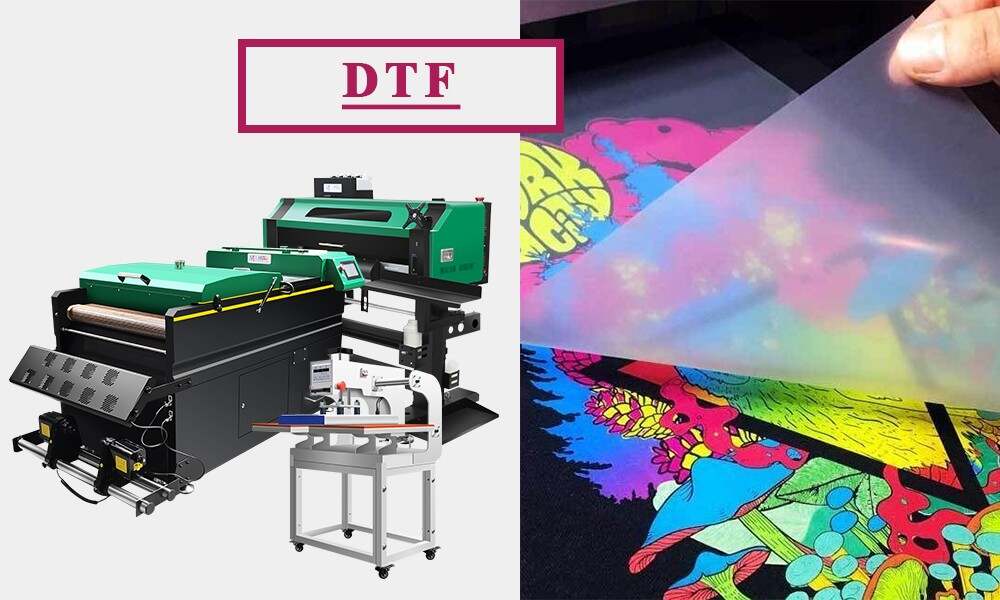Grasping DTF Printing: Advice for Achieving Vibrant and Durable Prints
Worldwide of textile printing, attaining dynamic and resilient prints is a coveted skill that can boost the quality of your output. Mastering DTF (Straight to Movie) printing requires a blend of technological expertise, accuracy, and interest to information. From picking the appropriate products to tweak print settings and refining post-printing ending up methods, there are countless variables that can influence the result of your prints. Recognizing just how to navigate these complexities can make all the distinction in between a sub-par result and a genuinely phenomenal one.

DTF Printing Fundamentals
For those brand-new to the globe of textile printing, recognizing the basics of DTF printing is vital to grasping this ingenious strategy. Straight to Film (DTF) printing is a contemporary method that involves moving designs from an unique movie onto numerous textiles using a heat press. Unlike standard methods like screen printing, DTF supplies benefits such as lively colors, intricate describing, and the capacity to print on varied products like cotton, polyester, and blends.
The process begins by printing the style on an unique DTF film utilizing a compatible printer with CMYK or CMYKW ink collections. When the design is printed, it is then cured with a heat press to develop a long lasting and lasting print. DTF printing is known for its ability to reproduce complex designs with high precision and color precision, making it a prominent option for companies looking to develop personalized clothing, marketing products, and a lot more.
Choosing the Right Products

Just as important is the selection of the glue powder. The sticky powder functions as a bonding representative in between the published style and the fabric, so it needs to have solid adhesion residential properties to ensure a long-lasting and long lasting transfer. Different fabrics may require different kinds of glue powders, so it is essential to match the powder to the textile kind for optimum results - DTF Printing. By carefully picking the ideal materials for DTF printing, printers can boost the high quality, vibrancy, and longevity of their prints.
Maximizing Publish Settings
When intending to achieve the best outcomes in DTF printing, precise interest to maximizing print settings is crucial for making certain accurate and top notch transfers onto textiles. One key element to think about when enhancing print settings is the resolution.
One more crucial setting to optimize is the print rate. Finding the right equilibrium in between speed and high quality is vital. While increasing the speed can boost efficiency, it may compromise the last print's clearness and color saturation. Trying out different rates and observing the results can assist determine the optimum setting for every print job - DTF Printing.
Moreover, fine-tuning color accounts and guaranteeing proper color administration are necessary for attaining exact and constant shades throughout different prints. By calibrating shade settings and profiles, printers can lessen color deviations and create consistent results, improving the overall print top quality and consumer satisfaction.
Preparing Artwork for DTF Printing
Transform the art work to CMYK color setting to make sure that the shades equate accurately from display to print. Bear in mind to mirror the address last design before printing to make sure that it moves correctly onto the garment. By complying with these actions and paying close attention to the details, you can prepare art work that is optimized for dynamic and durable DTF prints.
Post-Printing Finishing Methods
Executing efficient post-printing ending up strategies is important to boosting the durability and visual appeal of DTF prints on fabrics. When the printing process is full, using warm to the published layout is important (DTF Printing). Warmth not just help in healing the ink yet also ensures that the colors are durable and dynamic. A warm press maker evaluated the advised temperature level and stress setups can help achieve optimum results.
After warm pressing, removing the PET movie thoroughly is a critical step. This procedure needs to be done gradually and progressively to protect against any damage to the print. When the movie is eliminated, the print might require additional treating time to better establish the ink right into the textile. This step aids boost the washability and longevity of the print, guaranteeing it can endure several wash cycles without fading or cracking.
Additionally, cutting any type of excess movie around the layout can offer the final print a clean and specialist look. Taking the time to correctly end up DTF prints post-printing can dramatically affect the total quality and durability of the textile style.

Conclusion
To conclude, grasping DTF printing calls for a complete understanding of the basics, selecting ideal materials, maximizing print setups, preparing artwork effectively, and utilizing post-printing ending up techniques. By complying with these techniques and suggestions, one can achieve vivid and long lasting prints that fulfill their preferred top quality standards. Constant practice and focus to detail are important visit here in attaining successful results in DTF printing.
From picking the appropriate products to make improvements print setups and developing post-printing ending up techniques, there are various factors that can influence the result of your prints. Unlike traditional methods like display printing, DTF offers benefits such as vivid colors, elaborate detailing, and the ability to print here on diverse products like cotton, polyester, and blends.
Once the layout is published, it is then treated with a heat press to develop a long lasting and lasting print.When aiming to achieve the finest outcomes in DTF printing, thorough focus to maximizing print setups is vital for making certain top notch and accurate transfers onto fabrics.In verdict, understanding DTF printing requires a detailed understanding of the basics, picking suitable products, maximizing print settings, preparing artwork successfully, and making use of post-printing ending up techniques.
Comments on “DTF Printing Mastery: Raise Your Fabric Creations with Direct-to-Film Technology”